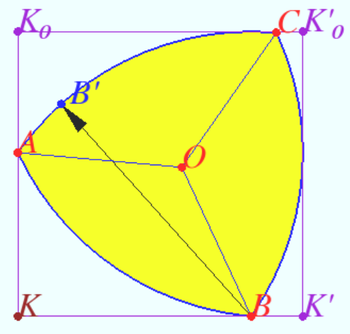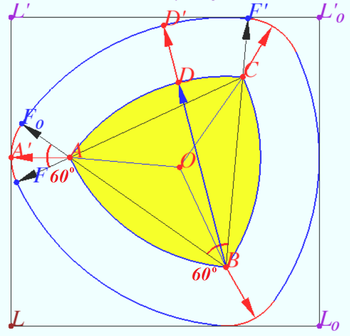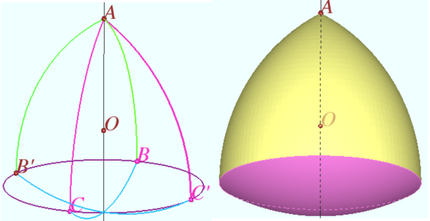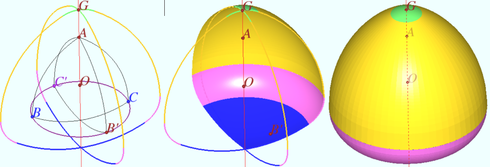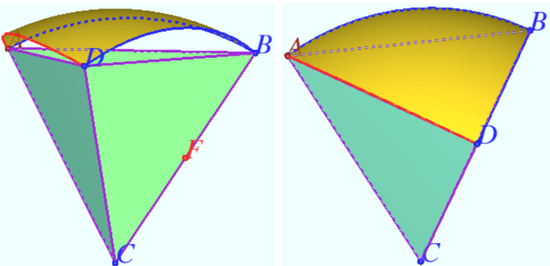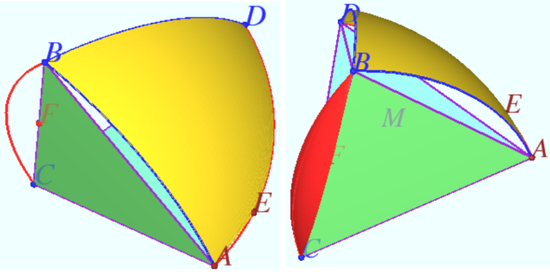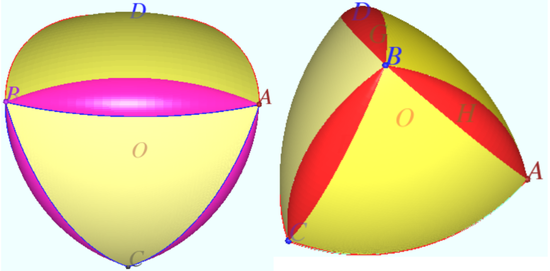Surface of constant width
A curve of constant width is a simple closed curve in the plane whose width (the distance between parallel supporting lines) is the same in all directions. A surface of constant width (orbiform) is a convex form whose width, measured by the distance between two opposite parallel planes touching its boundary, is the same regardless of the direction of those two parallel planes.
Contents
[hide]Reuleaux triangle
The boundary of a Reuleaux triangle is a constant width curve based on an equilateral triangle.
Let ![]() be equilateral triangle.
be equilateral triangle.
Let ![]() be the arc centered at
be the arc centered at ![]() with radius
with radius ![]()
Arcs ![]() and
and ![]() define similarly.
define similarly.
All points on this arcs are equidistant from the opposite vertex.
Distance is ![]()
vladimir.shelomovskii@gmail.com, vvsss
Reuleaux triangle analogue
Let ![]() be the boundary of a Reuleaux triangle,
be the boundary of a Reuleaux triangle, ![]() be the centroid of
be the centroid of ![]()
Let ![]() be the arc centered at
be the arc centered at ![]() with radius
with radius ![]() points
points ![]() and
and ![]() are collinear.
are collinear.
Let ![]() be the arc centered at
be the arc centered at ![]() with radius
with radius ![]()
![]() points
points ![]() are collinear.
are collinear.
Similarly define arcs from point ![]() to
to ![]()
The width of this curve is ![]()
vladimir.shelomovskii@gmail.com, vvsss
Rotation of the Reuleaux triangle
The left part of diagram shows the curve ![]() which is a Reuleaux triangle determined by the center
which is a Reuleaux triangle determined by the center ![]() and the vertex
and the vertex ![]()
The Reuleaux triangle ![]() is constructed by the rotation of the curve
is constructed by the rotation of the curve ![]() around axis
around axis ![]()
The right part of the diagram shows the surface which arose as the result of the rotation ![]()
vladimir.shelomovskii@gmail.com, vvsss
Rotation of the Reuleaux triangle analogue
The left part of diagram shows the curve ![]() which is a Reuleaux triangle analogy determined by the center
which is a Reuleaux triangle analogy determined by the center ![]() the vertex
the vertex ![]() and point
and point ![]() on curve analogue.
on curve analogue.
Similarly, we use the Reuleaux triangle ![]() is constructed by the rotation of the curve
is constructed by the rotation of the curve ![]() around axis
around axis ![]() and get the second position of the Reuleaux triangle analogue.
and get the second position of the Reuleaux triangle analogue.
The middle part of the diagram shows part of the surface. We can see all four parts of this surface shown by different colors.
The right part of the diagram shows the surface which arose as the result of the rotation curve ![]() It is impossible see the down side of the surface (blue) in this view.
It is impossible see the down side of the surface (blue) in this view.
vladimir.shelomovskii@gmail.com, vvsss
Meissner solids
Let ![]() be the regular tetrahedron.
be the regular tetrahedron.
The «sail» ![]() is the piece of sphere centered at the vertex
is the piece of sphere centered at the vertex ![]()
with radii ![]() bounded by the planes
bounded by the planes ![]() and
and ![]()
where ![]() is the mipoint of
is the mipoint of ![]()
The view along line ![]() is shown at the left part of diagram.
is shown at the left part of diagram.
Let point ![]() be the center of
be the center of
arc ![]() with radii
with radii ![]() shown by red.
shown by red.
The set of such arcs centered at points lying on the arc ![]()
create a part of lemon-shaped solid between arc ![]() of the plane
of the plane ![]()
and arc ![]() of the plane
of the plane ![]() shown at right part of diagram.
shown at right part of diagram.
There are two possibilityes to create Meissner solids using four sails and three lemon-shaped surfaces.
If lemon-shaped surfaces made triangle ![]() we name this solid as first Meissner solid.
we name this solid as first Meissner solid.
It is shown in left part of diagram.
If lemon-shaped surfaces have the common point ![]() we name this solid as second Meissner solid.
we name this solid as second Meissner solid.
vladimir.shelomovskii@gmail.com, vvsss





